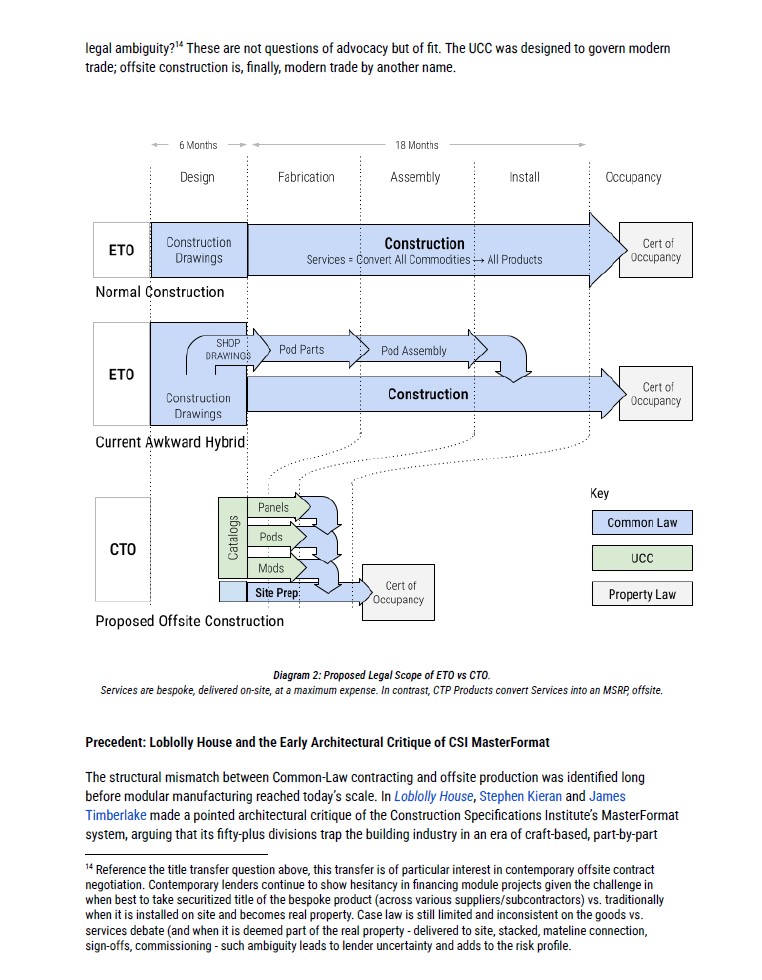Build Ahead
Updated Draft of Handshake: A Framework for Modernizing Construction Law
The Center for Offsite Construction (CfOC) has posted a major new draft of From Handshake to Hardware:
Questions & Pathways to Provide North American Offsite Construction with Uniform Law & Commerce on the Future of Design & Delivery platform. This expanded edition marks a significant step in the CfOC’s ongoing effort to build the legal, administrative, and evidentiary groundwork needed for industrialized construction to flourish in Configure-to-Order (CTO) marketplaces, nationwide.
At its core, Handshake is a whitepaper about contracts, but not in the narrow sense of drafting better clauses or revising standard templates. It is a paper about the deeper legal foundations that shape the built environment. Construction in the United States is still governed primarily by Common Law service agreements… contracts built for a world in which every building is a bespoke prototype, delivered through sequential on-site labor and professional services. That world is disappearing. Offsite manufacturing, modular assemblies, and Configure-to-Order (CTO) production are steadily remaking how buildings are conceived, procured, delivered, and maintained. Yet the legal structures surrounding construction have not kept pace. In many cases, they actively inhibit modernization.

Handshake argues that if offsite manufacturing is to scale, the industry must eventually embrace a hybrid legal framework: Common Law for site-built, service-driven scopes, and the Uniform Commercial Code (UCC) for productized scopes: the pods, panels, modules, façade cassettes, and integrated MEP assemblies fabricated offsite and delivered as goods. The paper introduces two new ideas: a legal mateline, and a commissioning step… two point where these two bodies of law meet. On one side of the line, professional services remain governed by traditional contract structures; on the other side, UCC principles would govern the sale, warranty, and risk allocation of manufactured components. The goal is not to replace existing agreements but to clarify where they fail to match the realities of modern industrialized construction.
This new draft expands Handshake significantly, especially in its treatment of the “Administrative Stack” that sustains Engineer-to-Order (ETO) construction. Chapters demonstrate how AIA contracts, CSI MasterFormat divisions, union jurisdictions, lien law, progress-payment systems, and inspection regimes interlock to support a century-old operating model that assumes buildings are made through services, not products. The paper argues that without a parallel administrative ecosystem for offsite manufacturing (a stack built around product identity, warranty continuity, interface standards, and UCC-compliant procurement) the CTO marketplace will remain fragmented and underdeveloped.
One of the most substantial additions in this version is the Appendix: Key Questions for Contracts & Statute. This appendix is more than a supplement; it is the conceptual engine of the paper. It presents a structured sequence of questions designed to guide statutory reviewers, legal scholars, and industry leaders through the core issues that must be examined if building components are to be governed like other manufactured goods. These questions address:
Ontology: When does a product cease to be a “good” and become “real property”?
Gap-Fillers and Defaults: Can the UCC’s uniform rules replace today’s fragmented, bespoke construction contracts?
Trust Mechanisms: How should warranties, notice, risk, and cure work across factory, carrier, and jobsite?
Continuity: How can legal definitions and remedies follow a product through fabrication, shipping, installation, and commissioning?
Modernization: What happens when machine-readable contracts, digital twins, and automated agents are executing decisions traditionally made by humans?
By framing these issues as questions rather than prescriptions, the Appendix positions the CfOC’s work as evidence-gathering rather than advocacy. Its function is to generate the data and clarity that uniform-law partners will eventually need when evaluating whether statutory updates are warranted. In other words, the Appendix transforms Handshake from an argument into a method—a way of documenting recurring conflicts, ambiguities, and burdens that stem from forcing industrialized components into a legal architecture built for artisanal construction.
The paper also articulates a phased roadmap for adoption. This pathway emphasizes consensus-building under ANSI procedures, the development of hybrid standard forms of agreement, and the use of pilot projects to generate case data. Through these mechanisms, the CfOC intends to gather the empirical record—title-transfer events, warranty conflicts, inspection logics, risk allocations, and payment structures—that can reveal where Common Law assumptions collide with product-based delivery. This data will form the evidentiary foundation required for responsible statutory review.
This newest draft of Handshake deepens its exploration of how a CTO marketplace can emerge, why it remains “phantom” today, and what legal barriers prevent repeatable modular products from circulating through the economy as confidently as any other class of goods. It also strengthens its articulation of the stakes: productivity, sustainability, housing supply, financial clarity, and risk reduction all hinge on aligning our contractual and statutory frameworks with the methods now defining the future of building delivery.
By publishing this expanded draft, the CfOC invites architects, contractors, developers, lenders, insurers, regulators, legal scholars, and policymakers to closely examine the questions posed in the Appendix and to participate in shaping the next generation of legal infrastructure for industrialized construction. The CfOC’s goal is not to dictate outcomes but to ensure that the eventual evolution of law is grounded in evidence, consensus, and fairness.
The whitepaper is now available for preview on the Future of Design & Delivery platform. The CfOC encourages readers to explore the full document, review the Appendix’s questions, and join the growing community working to bring clarity, interoperability, and modern legal architecture to the offsite construction economy.
